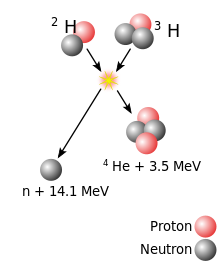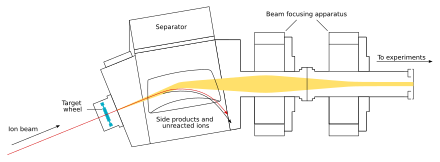Seaborgium
Chemistry experiments have confirmed that seaborgium behaves as the heavier homologue to tungsten in group 6.
The chemical properties of seaborgium are characterized only partly, but they compare well with the chemistry of the other group 6 elements.
[23] The definition by the IUPAC/IUPAP Joint Working Party (JWP) states that a chemical element can only be recognized as discovered if a nucleus of it has not decayed within 10−14 seconds.
This value was chosen as an estimate of how long it takes a nucleus to acquire electrons and thus display its chemical properties.
However, its range is very short; as nuclei become larger, its influence on the outermost nucleons (protons and neutrons) weakens.
In 1972, the HILAC accelerator received equipment upgrades, preventing the team from repeating the experiment, and data analysis was not done during the shutdown.
Evidence of element 106 was first reported in 1974 by a Russian research team in Dubna led by Yuri Oganessian, in which targets of lead-208 and lead-207 were bombarded with accelerated ions of chromium-54.
[56] A few months later in 1974, researchers including Glenn T. Seaborg, Carol Alonso and Albert Ghiorso at the University of California, Berkeley, and E. Kenneth Hulet from the Lawrence Livermore National Laboratory, also synthesized the element[57] by bombarding a californium-249 target with oxygen-18 ions, using equipment similar to that which had been used for the synthesis of element 104 five years earlier, observing at least seventy alpha decays, seemingly from the isotope seaborgium-263m with a half-life of 0.9±0.2 seconds.
The dispute on discovery, however, dragged on until 1992, when the IUPAC/IUPAP Transfermium Working Group (TWG), formed to put an end to the controversy by making conclusions regarding discovery claims for elements 101 to 112, concluded that the Soviet synthesis of seaborgium-260 was not convincing enough, "lacking as it is in yield curves and angular selection results", whereas the American synthesis of seaborgium-263 was convincing due to its being firmly anchored to known daughter nuclei.
The eight members of the Ghiorso group suggested a wide range of names honoring Isaac Newton, Thomas Edison, Leonardo da Vinci, Ferdinand Magellan, the mythical Ulysses, George Washington, and Finland, the native land of a member of the team.
There was no focus and no front-runner for a long period.Then one day Al [Ghiorso] walked into my office and asked what I thought of naming element 106 "seaborgium."
[59]Seaborg's son Eric remembered the naming process as follows:[60] With eight scientists involved in the discovery suggesting so many good possibilities, Ghiorso despaired of reaching consensus, until he awoke one night with an idea.
[60]The name seaborgium and symbol Sg were announced at the 207th national meeting of the American Chemical Society in March 1994 by Kenneth Hulet, one of the co-discovers.
[59] However, IUPAC resolved in August 1994 that an element could not be named after a living person, and Seaborg was still alive at the time.
[58] At first, IUPAC defended itself, with an American member of its committee writing: "Discoverers don't have a right to name an element.
However, Seaborg responded: This would be the first time in history that the acknowledged and uncontested discoverers of an element are denied the privilege of naming it.
[58]Seaborg commented regarding the naming: I am, needless to say, proud that U.S. chemists recommended that element 106, which is placed under tungsten (74), be called 'seaborgium.'
Whereas most of the isotopes of seaborgium can be synthesized directly this way, some heavier ones have only been observed as decay products of elements with higher atomic numbers.
[63] Depending on the energies involved, fusion reactions that generate superheavy elements are separated into "hot" and "cold".
In hot fusion reactions, very light, high-energy projectiles are accelerated toward very heavy targets (actinides), giving rise to compound nuclei at high excitation energy (~40–50 MeV) that may either fission or evaporate several (3 to 5) neutrons.
As the fused nuclei cool to the ground state, they require emission of only one or two neutrons, and thus, allows for the generation of more neutron-rich products.
Several radioactive isotopes have been synthesized in the laboratory, either by fusing two atoms or by observing the decay of heavier elements.
Seaborgium is expected to be a solid under normal conditions and assume a body-centered cubic crystal structure, similar to its lighter congener tungsten.
Nevertheless, the stability of the highest oxidation state is still expected to decrease as LrIII > RfIV > DbV > SgVI.
[3] The volatile seaborgium(VI) compounds SgCl6 and SgOCl4 are expected to be unstable to decomposition to seaborgium(V) compounds at high temperatures, analogous to MoCl6 and MoOCl4; this should not happen for SgO2Cl2 due to the much higher energy gap between the highest occupied and lowest unoccupied molecular orbitals, despite the similar Sg–Cl bond strengths (similarly to molybdenum and tungsten).
[71] Molybdenum and tungsten are very similar to each other and show important differences to the smaller chromium, and seaborgium is expected to follow the chemistry of tungsten and molybdenum quite closely, forming an even greater variety of oxoanions, the simplest among them being seaborgate, SgO2−4, which would form from the rapid hydrolysis of Sg(H2O)6+6, although this would take place less readily than with molybdenum and tungsten as expected from seaborgium's greater size.
The results indicated that seaborgium formed a volatile oxychloride akin to those of the other group 6 elements, and confirmed the decreasing trend of oxychloride volatility down group 6: In 2001, a team continued the study of the gas phase chemistry of seaborgium by reacting the element with O2 in a H2O environment.
In experiments conducted in 1997 and 1998, seaborgium was eluted from cation-exchange resin using a HNO3/HF solution, most likely as neutral SgO2F2 or the anionic complex ion [SgO2F3]− rather than SgO2−4.
Like its molybdenum and tungsten homologues, seaborgium hexacarbonyl is a volatile compound that reacts readily with silicon dioxide.



